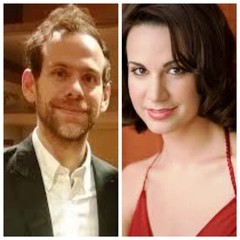|
Back
Mozart Mystery, Denk Delight New York
Isaac Stern Auditorium Carnegie Hall
02/15/2018 -
Wolfgang Amadeus Mozart: Symphony No. 40 in G Minor, K. 550
Bryce Dessner: Voy a dormir (World Premiere)
Ludwig van Beethoven: Concerto No. 5 for Piano and Orchestra (“Emperor”), Opus 73
Kelley O’Connor (Mezzo-Soprano), Jeremy Denk (Pianist)
Orchestra of St. Luke’s, Robert Spano (Conductor)

R. Spano (© Atlantasymphony.org)
An incomprehensible event happened during the first six minutes of the opening Mozart 40th Symphony last night. The elderly well-dressed couple to my right in Carnegie Hall opened their program and meticulously read through the written notes about the music through which they were supposedly hearing
Were this to take place during Webern or Nono or Boulez, I could understand it. But how in hell (I charitably thought) can supposedly civilized people (they carried a New York Times with them) listen to measures which, even more than the opening of Beethoven’s C Minor, rise out of nothingness, into the mist into a glorious panoply of color and radiance–and persist in scanning words in the program?
I was hardly obsessed with that. But for two seconds, I realized that Mozart’s pearls had been thrust before...not swine. But folks who never used their ears.
Enough. Enough to say that Robert Spano has departed the cotton plantations of Atlanta. And in this New York appearance, he conducted a swift, tense, beautifully phrased Mozart 40th Symphony with the Orchestra of St. Luke’s.
Granted, the Orchestra doesn’t have that sometimes electrifying alacrity of the New York Phil. Yet those minuscule blurs provided even more mystery to the work. Relatively few conductors giving the molto to Molto allegro can preserve the tension, that so-subtle shifting of colors to this movement, yet Mr. Spano never relented, never let the tautness dissolve into anything like a segue. It was ultimate craftsmanship turned into almost unbearable art.
The St. Luke’s winds led the second movement, with clarinet Jon Manasse and flute Elizabeth Mann offering those filigrees to the movement. And bless the horns for not even hinting a fluff during the scherzo.
When others note that the five-themed ending to the “Jupiter” are the ultimate counterpoint, I counter with the less outward but even more involved finale to the 40th. Mr. Spano again handled it with superb, no-nonsense conducting. With Mozart, ya plays da notes, and the sorcery is ordained

B. Dessner/K. O’Connor (© En.Wikipedia/Courtesy of the Artist)
It was with some trepidation that I awaited Bryce Dessner’s setting of the Swiss-Argentinian poet Alfonsina Storni, co-commissioned by Orchestra of St. Luke’s, Carnegie Hall and Los Angeles Chamber Orchestra. The four works were basically four of the most agonizing, beautiful, seascapes, a day before her suicide in 1938. (She had incurable breast cancer.) I had heard Mr. Dessner’s Réponse Lutoslawski several years ago and was impressed at his mathematical preciseness, the cold but magnetic lines of paean to Funeral Music.
How, though, would such a deft semi-dodecaphonist handle the lyrics written for mezzo-soprano Kelley O’Connor, Spanish words which offered underwater images (a golden fish, a winking octopus, “teeth of flowers, hands of herbs”?)
The surprising result was that this was a “different” composer. The algorhythms were turned into sometimes slight Iberian rhythms, the sharp colors of his original work were the subtle pastel colors of, say, Ravel’s Shéhérazade. And why not? Both poet Storni and Ravel were working with exotic landscapes, and Mr. Dessner, with different notes, unorthodox phrasing, offered the nuances of other lands.
Ms. O’Connor essayed the Spanish flawlessly, but more important, she could take Mr. Dessner’s lines make them into pictures. At the end of the first drifting poem, the music stops and her words for “the prickling pins of the sea” became an adoration. The crescendos in the third Lighthouse in the Night were so gently done.
And finally the poem written a day before the poet walked into the ocean. Like the title “I am going to sleep”, Ms. O’Connor sung above some marvelous orchestral moments, including a string chorale. The final words, “If he telephones again tell him not to keep trying for I have left” seemed almost impossible to set after the ravishing poetry of the other lines, but Mr. Dessner and Ms. O’Connor, with the faintest scintilla of bells concluded. Quietly, on a hung note.
One might imagine Bryce Dessner setting similar words to Sylvia Plath or Virginia Woolf. But once is more than sufficient.
After the intermission, Jeremy Denk, as always, sailed through the Beethoven “Emperor”. That is unfair, of course. The great pianist looks like he’s enjoying ever moment with Mr. Spano. That kind of frolicking was natural for the final rondo. But in the first two movements, one couldn’t help reveling in those innumerable trills, the double octaves up and down the keyboard. This was never the moody, gigantic Promethean Beethoven concerto, and some might have been deceived that Mr. Denk was not weighty enough. It isn’t his fault that everything looks so easy. It isn’t his fault that his joyous movements, rhythms, his hands hoisted high above the keyboard look so showy.
That’s just Jeremy Denk, for whom all music seems something between a caper and a celebration.
The “Emperor” was played with joy, the Mozart with mystery. Yet leaving Carnegie Hall, the sounds of Ms. O’Connor and Mr. Dessner’s orchestral colors so furtive, so mysterious became a vivid remembrance.
Harry Rolnick
|